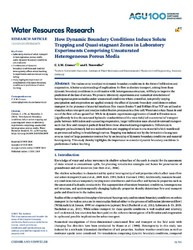How Dynamic Boundary Conditions Induce Solute Trapping and Quasi-stagnant Zones in Laboratory Experiments Comprising Unsaturated Heterogeneous Porous Media
DOI: https://doi.org/10.1029/2018WR024470
Persistent URL: http://resolver.sub.uni-goettingen.de/purl?gldocs-11858/9079
Persistent URL: http://resolver.sub.uni-goettingen.de/purl?gldocs-11858/9079
Cremer, C. J. M.; Neuweiler, I., 2019: How Dynamic Boundary Conditions Induce Solute Trapping and Quasi-stagnant Zones in Laboratory Experiments Comprising Unsaturated Heterogeneous Porous Media. In: Water Resources Research, Band 55, 12: 10765 - 10780, DOI: 10.1029/2018WR024470.
 |
Dokument öffnen: |
The vadose zone is subject to dynamic boundary conditions in the form of infiltration and evaporation. A better understanding of implications for flow and solute transport, arising from these dynamic boundary conditions in combination with heterogeneous structure, will help to improve the prediction of the fate of solutes. We present laboratory experiments and numerical simulations of heterogeneous porous media under unsaturated conditions where controlled, temporally varying precipitation and evaporation are applied to study the effect of dynamic boundary conditions on solute transport in the presence of material interfaces. Dye tracers Eosine Y and Brilliant Blue FCF are utilized to visualize solute transport and analyze redistribution processes in a flow cell. Water and solute fluxes in and out of the flow cell are quantified. While in dynamic experiments application of small infiltration rates (significantly below the saturated hydraulic conductivities of the materials) led to a reversal of transport paths between infiltration and succeeding evaporation, larger infiltration rates altered downward transport such that flow and transport paths differed from those observed during evaporation. Differences in transport paths ultimately led to a redistribution and trapping of solute in one material which manifested as pronounced tailing in breakthrough curves. Trapping was induced not by the formation of a stagnant zone as result of large parameter contrast but by an interplay of dynamic boundary conditions and material heterogeneity. This study thereby highlights the importance to consider dynamic boundary conditions in predictions of solute leaching.
Statistik:
ZugriffsstatistikSammlung:
Schlagworte:
laboratory experimentunsaturated porous media
conservative solute transport
dynamic boundary conditions
This is an open access article under the terms of the Creative Commons Attribution License, which permits use, distribution and reproduction in any medium, provided the original work is properly cited.

